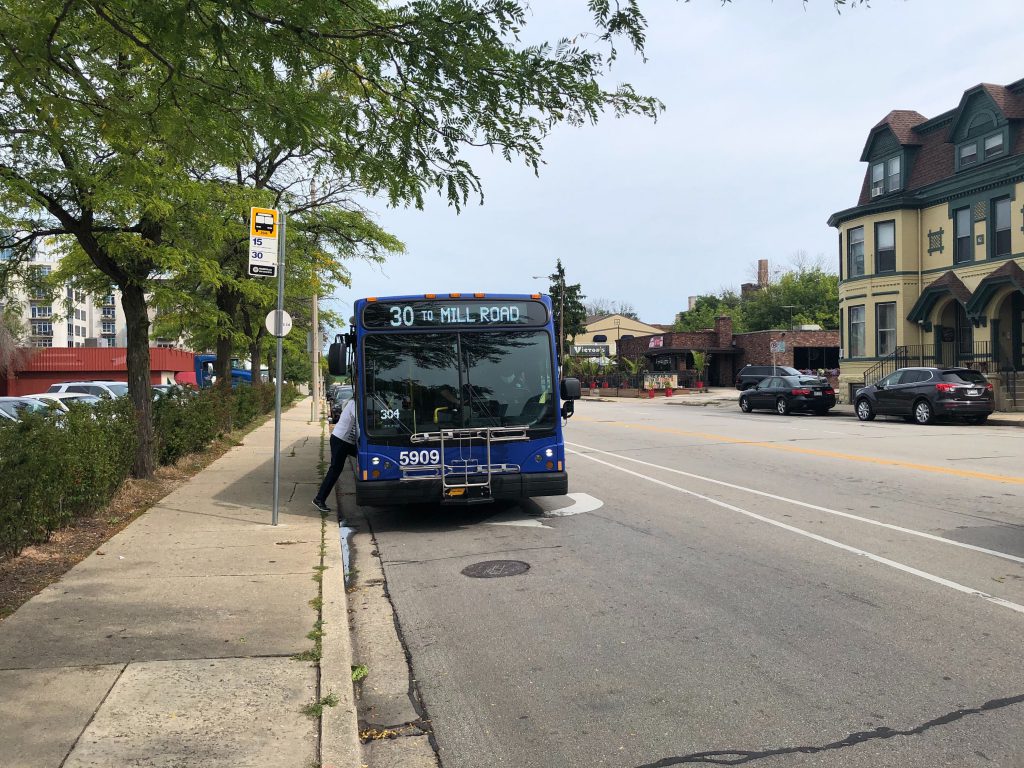No Good Options For County Transit
Facing huge shortfall, MCTS can only balance budget with harmful or unpopular changes, report finds.
The Milwaukee County Transit System (MCTS) is in peril and any possible solutions point to a grim future.
The transit system has been struggling with insufficient funding and declining ridership for years. Then the COVID-19 pandemic hit, and MCTS was showered with an unprecedented $191 million in federal funding. This money has buoyed the flagging system, but it’s expected to run out by 2024. Meanwhile, ridership has not returned to pre-pandemic levels.
In 2019, the last time a budget was created for transit without the help of federal COVID-19 stimulus, Dan Boehm, MCTS managing director, explained the problem to the Milwaukee County Board in simple terms: “We are out of local funding options and are at a crossroads.”
The direction proposed at the time was a 10% cut in transit service across the board. Former County Executive Chris Abele seemed intent on pursuing this path, but at the last minute made use of some healthcare cost savings to significantly blunt the cuts to the system.
The 10% cut proposed for 2020 came on the heels of a 3% service cut made in the 2019 budget, and was in response to a projected budget deficit in transit between $6 and $8 million. The situation is now far more dire. In March, the Milwaukee County Comptroller released a five-year financial forecast for the county, which estimated the transit system would have a budget gap in 2025 of approximately $32.9 million.
Transit in Milwaukee County does not have a dedicated funding source. Its budget each year comes from property taxes, farebox revenue, state operating aid and federal grants for projects. Funding is made even more complicated by the fact that the state won’t provide funding for capital projects and the federal government won’t provide funding for operations.
The service is not legally mandated by law as other county services are, and state support relies on the Republican-controlled Legislature. In the 2021-2023 biennial budget, the Legislature cut funding to the transit system by $32.7 million because it had received so much federal stimulus funding. Gov. Tony Evers reduced the cut to just $12.9 million using some of the state’s American Rescue Plan Act funding.
In the new strategy report from MCDOT, the agency notes, “It is anticipated that the Wisconsin State Legislature will pursue transit operating funding cuts in the 2023-2025 biennium believing that pending federal infrastructure funding will provide the system with increased funding.”
But, MCDOT reports, funding from the federal infrastructure bill will require a 20% match, will only be eligible for capital projects and the amount the county will receive is still undetermined.
One strategy is to increase fares on all transit services, including paratransit and reduced fare rides for seniors and persons with disabilities. This course would reduce ridership and disproportionately impact low-income and minority populations.
County policymakers could increase the amount of annual tax levy that goes toward transit. But the county already has a structural budget deficit just to continue as it currently exists, so increasing tax levy support for transit would necessitate cuts to other county departments and services.
The only mechanism beyond raising tax levy support for transit that the county has in its control is the Vehicle Registration Fee. The county board and former executive Abele had many battles over the VRF and whether, and by how much, it should be increased. MCDOT notes that filling revenue with VRF would require it to be “increased substantially” and that this “will likely be politically and practically unfeasible to propose much less enact.”
There are also one-time revenues the county could realize by canceling, or delaying the North-South Transit Enhancement project, which will likely be a second Bus Rapid Transit line. This, however, would only defer the deficit, and would contradict existing county policies and be politically unpopular.
Finally, there is the option of cutting service and staff across the system, including administration. This has no tangible benefit for the system, other than to balance the budget. MCDOT points out that cuts will further reduce ridership, increase poverty and hardship for people who rely on transit, add more cars to the roads, increase vehicle emissions, and cause jobs to be lost in the system and among the public. It will also make transit service less convenient, be politically unpopular and will contradict county policies and the goal to become the healthiest county in Wisconsin.
Read the MCDOT report here.
If you think stories like this are important, become a member of Urban Milwaukee and help support real, independent journalism. Plus you get some cool added benefits.
MKE County
-
RNC Will Cause Some County Services To Be Moved to Wauwatosa
 Jul 12th, 2024 by Graham Kilmer
Jul 12th, 2024 by Graham Kilmer
-
Hank Aaron State Trail Will Be Closed For RNC, State Fair
 Jul 12th, 2024 by Graham Kilmer
Jul 12th, 2024 by Graham Kilmer
-
MCTS Designing New Bus Shelters
 Jul 10th, 2024 by Graham Kilmer
Jul 10th, 2024 by Graham Kilmer
Transportation
-
MCTS Adds 28 New Buses
 Jul 13th, 2024 by Graham Kilmer
Jul 13th, 2024 by Graham Kilmer
-
MCTS Designing New Bus Shelters
 Jul 10th, 2024 by Graham Kilmer
Jul 10th, 2024 by Graham Kilmer
-
MCTS Updates RNC Bus Detours To Better Serve Downtown, Riders
 Jul 9th, 2024 by Jeramey Jannene
Jul 9th, 2024 by Jeramey Jannene























No money for buses but another $40 billion taxpayer dollars this week for Joe Biden’s war against Russia…
5/9/2022 – Biden tells Congress to ‘immediately’ pass $40 billion for war against Russia… https://www.cnn.com/2022/05/09/politics/biden-congress-ukraine-aid/index.html
It’s insane just how much republicans hate public transportation, Wisconsin has a massive budget surplus and they go ahead with tax cuts, instead of funding municipalities and districts facing financial problems. There are so many benefits to funding these services, even for car drivers, like reducing drivers on the road, we allocate so much to fighting wars while cities and and our infrastructure crumble
If persons willing to work and without a car can not get to a job because of a lack of public transportation, the local economy suffers. If Republican business owners complain about not getting job applicants, someone needs to ask them why many locate their businesses in rural areas where public transportation does not exist.